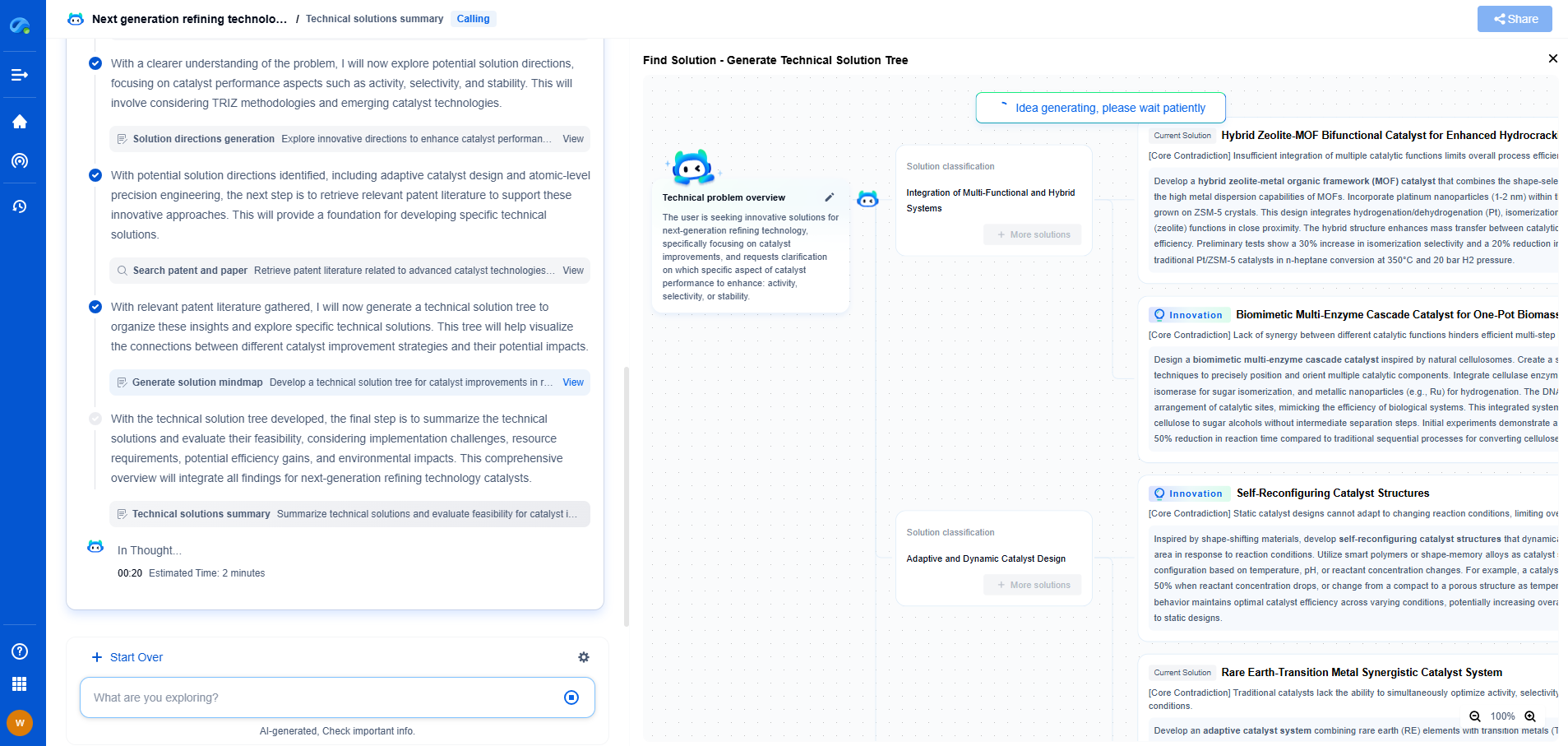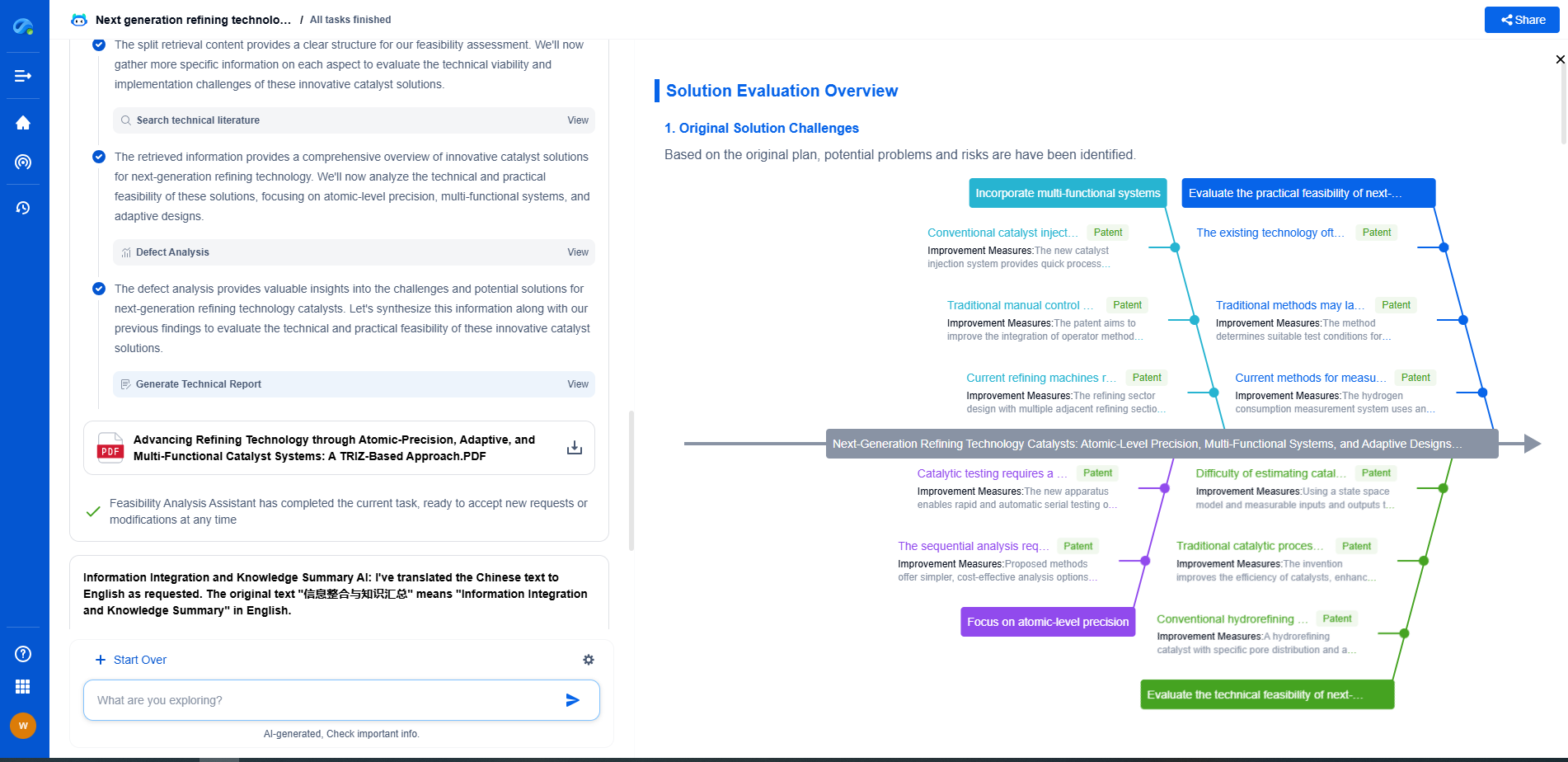What Is the Role of Calendering in Battery Production?
JUN 20, 2025 |
The production of batteries, particularly lithium-ion batteries, is a complex process involving various stages of material preparation and assembly. One crucial step in this process is calendering, a mechanical technique used to enhance the physical properties of the electrode materials. Understanding the role of calendering in battery production is essential for optimizing performance, ensuring consistency, and reducing costs.
The Basics of Calendering
Calendering is a process that involves compressing and smoothing electrode materials by passing them through a series of heated rollers. This mechanical process is primarily used to achieve uniform thickness and density across the electrode sheets, which are essential for efficient battery performance. By precisely controlling the pressure applied to the materials, manufacturers can produce electrodes with optimal conductivity and mechanical stability.
Enhancing Electrode Density and Uniformity
One of the primary goals of calendering in battery production is to improve the density and uniformity of the electrode materials. When electrode sheets are consistent in thickness and density, they facilitate even current distribution during operation, enhancing the overall performance and lifespan of the battery. Uniform electrodes also contribute to a more efficient use of active materials, leading to better energy storage capacity and reduced material waste.
Improving Electrical Conductivity
The calendering process plays a significant role in improving the electrical conductivity of electrode materials. By compressing the active particles closer together, calendering reduces the resistive pathways within the electrode, allowing for more efficient electron flow. This enhancement in conductivity is critical for increasing the rate capability of batteries, making them suitable for high-power applications such as electric vehicles and portable electronics.
Ensuring Mechanical Stability
Mechanical stability is another vital aspect of battery electrodes, and calendering contributes significantly to this characteristic. Well-calendered electrodes exhibit improved adhesion between the active materials and the current collector, reducing the risk of delamination during battery cycling. This stability ensures that the electrodes maintain their integrity over time, preventing capacity loss and extending the battery’s life.
Balancing Pressure and Material Properties
Achieving the desired results from the calendering process requires a delicate balance between the applied pressure and the inherent properties of the electrode materials. Excessive pressure can damage the materials or cause them to become too dense, leading to diminished performance. Conversely, insufficient pressure might not adequately enhance the material properties, resulting in suboptimal battery performance. Manufacturers must carefully calibrate their calendering equipment to accommodate the specific characteristics of the materials used.
The Impact of Calendering on Battery Performance
The effectiveness of calendering directly influences the performance metrics of batteries, including energy density, power density, and cycle life. By optimizing electrode properties through calendering, manufacturers can produce batteries that offer higher energy storage capacities, faster charging rates, and longer operational lifespans. This process is particularly crucial in the production of high-performance batteries for demanding applications where efficiency and reliability are paramount.
Advancements and Innovations in Calendering Technology
As the demand for high-performance batteries continues to grow, advancements in calendering technology are essential to meet these requirements. Innovations such as precision-controlled roller systems, real-time monitoring of electrode properties, and the development of new materials compatible with calendering processes are shaping the future of battery manufacturing. These advancements not only improve the efficiency and quality of the calendering process but also contribute to more sustainable and cost-effective battery production.
In conclusion, calendering is a vital step in the battery production process that significantly impacts the performance and longevity of the final product. By enhancing electrode density, uniformity, electrical conductivity, and mechanical stability, calendering ensures that batteries meet the high standards required for modern applications. As technology advances, the role of calendering in battery production will continue to evolve, driving innovation and efficiency in the industry.
Accelerate Breakthroughs in Fuel Cell and Battery Innovation—with the Power of AI
From solid-state battery breakthroughs to high-efficiency hydrogen fuel cells, keeping pace with fast-evolving chemistries, global patent landscapes, and emerging application pathways is an ever-growing challenge for R&D and IP professionals.
Patsnap Eureka, our intelligent AI assistant built for R&D professionals in high-tech sectors, empowers you with real-time expert-level analysis, technology roadmap exploration, and strategic mapping of core patents—all within a seamless, user-friendly interface.
Whether you're optimizing cathode formulations, evaluating electrolyte stability, or navigating the crowded patent space around battery pack design, Eureka empowers you to move faster and with greater confidence.
Start your journey with Patsnap Eureka today—streamline your research, enhance decision-making, and power the future of energy with AI-driven clarity.
- R&D
- Intellectual Property
- Life Sciences
- Materials
- Tech Scout
- Unparalleled Data Quality
- Higher Quality Content
- 60% Fewer Hallucinations
Browse by: Latest US Patents, China's latest patents, Technical Efficacy Thesaurus, Application Domain, Technology Topic, Popular Technical Reports.
© 2025 PatSnap. All rights reserved.Legal|Privacy policy|Modern Slavery Act Transparency Statement|Sitemap|About US| Contact US: help@patsnap.com

